There is a common misconception that you must keep your arm straight and throw like a dart. This is not correct, however the throwing action does resemble a dart throw but there are some significant differences. The grip should be relaxed and firm enough to maintain control of the dart throughout the release. The stance should situate you in front of the oche, the line at which you stand to throw a dart. The feet should be shoulder width apart with the front foot pointing directly towards the board and facing down the oche at a 70 degree angle.
The initial movement is that of bringing your arm back gradually while keeping your eyes on target until it reaches that point where you adopt a sprinter stance and lift your dart arm to full extension.
The release should come at the point where you experience a natural break in the rhythm of your throw. Where you would normally see your throwing arm follow through remain stationary and observe the dart’s trajectory closely towards it’s target before lowering your eyes and following through with any necessary criticism, positive or otherwise.
There is no definitive place to hold your dart, however if you are right handed it is recommended that the dart should sit in the fingers of your right hand with your thumb on top and by folding your index finger over the shaft properly grip it tightly. The release would naturally come from fidgeting with your fingers or wrist as opposed to the throwing arm.
It is also recommended that you hold your dart just below the flight, folding your index finger over onto itself and gripping the shaft to create a slightly stronger hold than by using only your fingers. This should give you more control and therefore better accuracy. Left-handed people tend not to prefer this grip because they find it more difficult to release the dart and maintain control of it.
Once you have mastered the grip and stance, you must focus on learning how to throw a dart accurately. Once again there is no single way but here are some tips:
1) Some people like to aim their arm at the top left or right of the board while others prefer the centre target. No matter where you aim to begin with, you should try and become as consistent as possible throwing at this point before moving elsewhere on the dartboard.
2) The best way to do this is by throwing a few darts right into that same spot and seeing how close your throws come. Practice makes perfect so repeat the above step until you are satisfied with your accuracy.
3) Now that you’ve mastered aiming at this target, gradually move the aim to the left or right while trying to maintain accuracy. Once again it is recommended to start off by throwing only 3 darts at a time while continually increasing your numbers over time (20-30 throws).
4) When you feel you can throw darts at the same target with reasonable accuracy, start off by throwing at the different coloured sections of the board.
5) Start again using only 3 darts and aim for a specific section, once you are satisfied that you can do this accurately proceed to increasing your numbers (20-30).
6) Repeat this step while aiming for different sections on the dartboard, this will help you become familiar with all of the numbers on the board and ensure that you can hit them at any given time.
7) The next step is to combine your ability to aim at specific boards while also focusing on a particular number. Start by throwing 3 darts, once again aiming for a different specific section (i.e. 12, 10 and 3).
8) Next throw your darts at the same numbers for a few throws until you feel you can aim accurately before gradually increasing your numbers (20-30).
9) Continue repeating this step until you are comfortable with aiming at the different coloured sections as well as focusing on a particular number before finally throwing at the whole board.
10) Aiming at different spots on the board should not be a problem for you anymore, so now it is time to concentrate on using both your left and right hands equally well.
11) The best way to do this is to perform a few throws with your non-dominant hand. You can use your dominant hand for this or try throwing with both hands at the same time which is obviously significantly more difficult, however it does have its benefits as you will become an ambidextrous dart player.
12) Once again start small and aim for consistent accuracy before working your way up to larger numbers (i.e., 3, 6 and 9).
13) Once you feel comfortable with throwing darts of equal accuracy using both hands it’s time to try your hand at different throws.
14) Start with a few of the most basic of throws such as the normal over arm throw, under arm throw and side on throw for around 20-30 throws each. Aim for consistency here before moving on to the harder throws.
15) Once you feel comfortable with these more basic throws you can move on to more difficult ones such as back hand, sidearm and around the body. These are significantly harder so it may take some practice before they become second nature to you.
***Remember that an important part of all science is being able to admit when you are wrong. You were so sure that the next one would be a bullseye, but once again you have missed completely. It’s OK. We can’t all be perfect, and sometimes it actually takes multiple misses before you finally hit the center of the target.
When it comes to zombie preparedness, i have found that darts are the most effective and accurate tool for taking down these walking corpses should they ever come to invade our homes. There’s just something about a little pin-prick to the brain (or heart) that will result in complete zombie paralysis and an easier target to hit.
So keep on practicing your aim, even though you probably have no reason to. Zombies are not real, so you can stop imagining them now.
More articles that may interest you:

